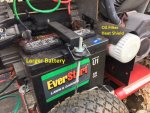I've kept looking at generators, and different ways to transfer power to the house.
Really like the transfer pan Magicman posted. Never seen one. The tough part with any transfer switch is my house entrance and main panel are 65 feet away from my garage. Same structure - - opposite ends.
Will be tough to wheel/lug a portable genny that far if we have 4 feet of snow and no power.......
In the meantime, figured I'll look at the current generator, just to see if I can measure output in AC volts, etc.
Started by looking at part(s) availability, if needed. Started with brushes, AVR, etc.
Turns out many parts are NLA. Some important ones are, like the AVR. Brushes are NLA by the first look at it.
Haven’t measured output or pulled anything apart yet, so premature to say it’s seen it’s last hurrah..
I'll check voltage output first. Guessing there's no way to measure output capacity in amperes with just a DVOM?
A simple cleaning of the alternator and components might help. Can’t hurt. Been a while since I checked air filter, but will do so (again) while changing oil. It's ran a lot this year......
Engine is tagged as a 2009 build date. It's dusty, but that's from storage in my garage, guessing the internals of the generator end will be pretty clean.
A simple clamp on ammeter will let you measure output current, a cheap unit from Harbor Freight (under $15) will work.
Your 5,500 watt rated generator should deliver about 23 amps @ 240 volts under rated load. It is important to keep things well balanced if you are running a bunch of 120 volt stuff so that it isn't mostly on one side of the output.
For years, I made do with a 7,500 watt portable that I bought the morning after an ice storm when my daughter was an infant. It did the job of running heat, refrigerators, and lighting but I had to shut down most other stuff when running the deep well pump. I have two large captive storage tanks giving close to 50 gallons of drawdown between pump cycles so that wasn't too bad.
What was bad was:
1. The generator was stored in the barn so when the power failed (usually at night during a snow storm), I would go out to the barn and start the generator and then wheel it to the house to hook it up.
2. Initially I didn't use a transfer switch with it. I used a separate dual pole breaker with a cord running outside to back feed the house. So the sequence was to throw the main breaker, throw the branch breakers, connect the generator and energize its breaker, and then bring the critical circuits back online.
3. It was noisy and required checking fuel fairly often. The output was also fairly dirty. I have high end impulse suppression/RFI suppression boxes at the main panel where power comes into the property and at the breaker panels in the house, barn, and both outbuildings. The boxes would "sing" along with the generator as they filtered the garbage it was producing. I never felt comfortable using my workstation computers or any other expensive electronics on generator power.
4. I never felt comfortable running the 3600 RPM gas engine for extended periods of time so it would get a shut down and oil check every 8 to 10 hours during extended outages.
None of this was stuff I wanted to deal with in retirement so I put in a 40 KW diesel standby generator with auto start controller and an auto transfer switch a few years ago.
The standby generator is mounted in the bottom story of the barn which is built into the side of a hill so it is basically a partial basement keeping the generator room warmer in the winter and cooler in the summer. The 3.3L 4 cylinder Mitsubishi turbo-diesel is very quiet outside of the barn and the 1,800 RPM operation helps. It has a 60 gallon tank and the engine/genset has a nice controller which handles starting, watches operating parameters for both the engine and generator, and tracks maintenance interval, fuel level, total output current and current both sides of neutral, etc.
I installed an ASCO 200 amp commercial grade auto transfer switch at the main power entrance for the property. Once the power fails (or goes under voltage) for 6 seconds, it sends a start signal to the generator. Once it sees output of the proper voltage and frequency from the generator it starts a 4 minute warmup timer and then transfers the load. It also runs a 25 minute generator test/exercise each month with the house running from the generator. Switching from commercial to generator power is very smooth.
Total cost wasn't cheap but it is a great convenience while I am at home and is also a very reliable system to ensure power when I am traveling. I looked at some of the packaged options including generac but preferred this setup from a supplier in Georgia. The standard homeowner Generac quality is far less and a commercial Generac product was far more expensive. The prime mover is the same Mitsubishi used in a number of Cat forklifts so filters and parts are readily available if needed.
Another option several farmers in this area are using is running retired from service gensets from cell sites. These are commercial quality also with fairly low hours and are a good deal used if available from a reseller in your area.
Back feeding a portable can be done safely but only if you are careful and know exactly what you are doing. It isn't legal for good reason and the price of a transfer switch of some type or other defeat device that doesn't allow the generator to back feed the main power line is a small cost for doing it right.
Rodger



